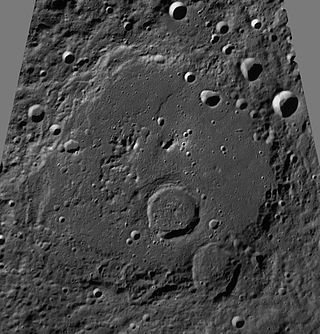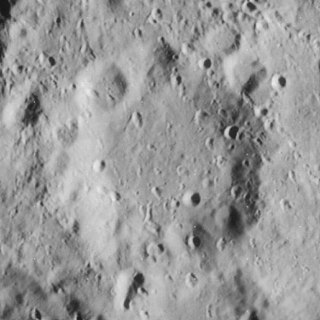
Autolycus is a lunar impact crater that is located in the southeast part of Mare Imbrium. The crater is named after the ancient Greek astronomer Autolycus of Pitane. West of the formation is Archimedes, a formation more than double the size of Autolycus. Just to the north is Aristillus, and the outer ramparts of these two craters overlap in the intermediate stretch of the lunar mare.

Aliacensis is a lunar impact crater that is located in the rugged southern highlands of the Moon. The crater Werner is located just to its north-northwest, and a narrow, rugged valley lies between the two comparably sized formations. To the southwest is Walther, and Apianus is to the northeast. Aliacensis is named after the 14th century French geographer and theologian Pierre d'Ailly in 1935. It is from the Nectarian period, which lasted from 3.92 to 3.85 billion years ago.

Heraclitus is a complex lunar impact crater that lies in the rugged southern highlands of the Moon. The crater Licetus forms the northern end of the formation. Just to the east is Cuvier, and due south is Lilius. Just to the west of Heraclitus is the small satellite crater Heraclitus K, to the south of which is a pair of larger overlapping craters, Lilius E and Lilius D.

Apianus is a lunar impact crater that is located on the rugged south-central highlands of the Moon. It is named after 16th century German mathematician and astronomer Petrus Apianus. It is located to the northeast of the crater Aliacensis, and to the northwest of Poisson. The worn crater Krusenstern is attached to the west-northwestern rim.

Donati is a lunar impact crater that is located in the rugged south-central highlands of the Moon. It lies just to the northwest of the crater Faye, and the two outer rims are separated by a gap of less than 10 kilometers. To the north is the comparably sized Airy, and farther to the southeast is Playfair. Donati is 36 kilometers in diameter.

Biela is a lunar impact crater that is located in the rugged highlands of the southeastern Moon. It is named after Austrian astronomer Wilhelm von Biela. The crater lies to the east of Rosenberger, to the southeast of the Watt–Steinheil double crater.

De La Rue is the remnant of a lunar impact crater, or possibly several merged craters, creating a formation sometimes called a walled plain. It lies in the northeastern part of the Moon on the near side, and so appears foreshortened due to its location. This formation lies to the north-northwest of the prominent crater Endymion, just beyond the eastern extreme of Mare Frigoris. The crater Strabo intrudes into the northern part of De La Rue's northern rim, and the smaller Thales is attached to the northwestern part of the wall.

Deluc is a lunar impact crater that lies in the southern highlands of the Moon. It is located to the south-southeast of the crater Maginus, and the huge Clavius. Due east of Deluc is the somewhat larger crater Lilius. It is 47 kilometers in diameter and 3.3 kilometers deep. It is from the Pre-Imbrian period, which lasted from 4.55 to 3.85 billion years ago.

Curtius is a lunar impact crater that is located in the southern part of the Moon. From the Earth the crater appears foreshortened, making it more difficult to observe detail. Nevertheless, this is a large crater that can be readily found in even small telescopes. Curtius is located within one crater diameter of the still-larger Moretus to the southwest. To the northeast is the smaller Pentland. Curtius is 95 kilometers in diameter and 6.8 kilometers deep. It is from the Nectarian period, 3.92 to 3.85 billion years ago.

Licetus is a lunar impact crater on the near side of the Moon, in the rugged southern highland region. It lies to the south of the walled plain Stöfler, and is attached to the northern rim of the sub-divided crater Heraclitus. Just to the southeast is Cuvier. Licetus is 75 kilometers in diameter and 3.8 kilometers deep. It is from the Pre-Nectarian period, 4.55 to 3.92 billion years ago.

Darwin is a lunar impact crater of the type categorised as a walled plain. It lies in the southeastern part of the Moon, and is sufficiently close to the limb to appear significantly foreshortened when viewed from the Earth. Attached to its southern rim is Lamarck. To the northeast is the dark-floored crater Crüger.

Schwarzschild is a large lunar impact crater, approximately 211 kilometers (131 mi) in diameter. It is located in the northern part of the Moon's far side. The nearest craters of note are Seares to the northeast, and Gamow to the southeast. It was named after German physicist and astronomer Karl Schwarzschild (1873–1916).

Heinsius is an eroded lunar impact crater that lies in the southwestern part of the Moon. It is named after German astronomer Gottfried Heinsius. It is located to the northwest of the prominent crater Tycho, and rays from that formation pass to the north and south of Heinsius as well as marking the rim and interior with material. To the south-southwest of Heinsius is the larger walled plain Wilhelm.

Repsold is a lunar impact crater that is located at the western end of the Oceanus Procellarum. It lies to the northeast of the crater Galvani and southeast of the walled plain Volta. Due to its proximity to the northwestern limb of the Moon, this crater appears highly foreshortened when viewed from the Earth. It is named after Johann Georg Repsold, a German astronomer.

Faye is a heavily eroded lunar impact crater in the rugged southern highlands of the Moon. It is named after French astronomer Hervé Faye. It is attached to the northeastern rim of the crater Delaunay, with Donati located just a few kilometers to the northeast. It forms part of a chain of craters of increasing size to the southwest that continues with La Caille and ends with the walled plain Purbach.

Epimenides is a lunar impact crater that is located in the southwestern part of the Moon's near side, just to the east of the oddly shaped crater Hainzel. Just to the north and northeast is Lacus Timoris, a small lunar mare. The crater is 27 kilometers in diameter and 2,000 meters deep. It may be from the Pre-Nectarian period, 4.55 to 3.92 billion years ago.

Proctor is the remnant of a lunar impact crater that is located to the southeast of the prominent crater Tycho. It lies just to the north of the huge walled plain Maginus. To the north is the crater Saussure and to the northwest, just to the east of Tycho, lies Pictet. Proctor is 52 kilometers (32 mi) in diameter and its walls are 1,300 meters (4,300 ft) high. It is from the Pre-Imbrian period, which lasted from 4.55 to 3.85 billion years ago.

Kinau is a small, eroded lunar impact crater that is located in the low southern latitudes of the Moon. It lies to the southeast of the crater Jacobi, and about equally far to the north-northwest of Pentland. It is 42 kilometers in diameter and two kilometers deep. It may be from the Pre-Nectarian period, 4.55 to 3.85 billion years ago.

Ibn Firnas is a lunar impact crater on the far side of the Moon. Attached to the exterior of its southwestern rim is the prominent crater King. Only a few kilometers to the north, separated by a rugged stretch of terrain, is the larger crater Ostwald.

Omar Khayyam is a lunar impact crater that is located just beyond the northwestern limb of the Moon, on the far side from the Earth. It lies in a region of the surface that is sometimes brought into view of the Earth due to libration, and under favorable lighting it can be viewed from the edge. However under such circumstances not much detail can be seen, and the crater is best viewed from orbit.




















